Lymphocytes - Introduction
Introduction
Lymphocytes account for around a third of all circulating leukocytes and are formed in a variety of lymphoid tissues. They are functionally divided into T cells, B cells and NK Natural Killer (NK) cells. Lymphocytes vary in size (6-30µm) and are classified as small, medium or large. Large cells are either activated lymphocytes or NK cells. The vast majority of circulating lymphocytes are small and of a similar size to erythrocytes. Histologically they are round with a large densely staining nucleus and a thin, often indistinct, rim of cytoplasm. While NK cells can be distinguished by their large granules and kidney shaped nucleus, B and T cells appear the same histologically.
Lymphocytes, along with the associated supporting cells, form the immune system and recognise antigens, produce antibodies and destroy pathogens.
Development
Both T and B lymphocytes develop from a common stem cell (CFU-L's) during lymphopoiesis.

